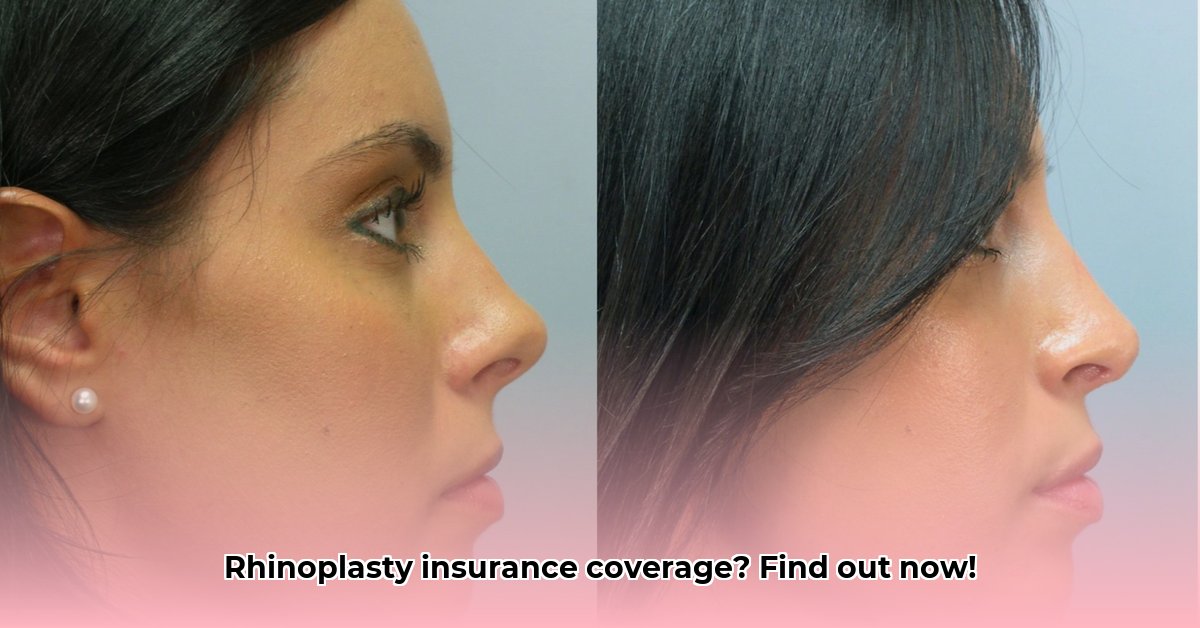Thinking about a nose job? It’s a big decision, and the cost can be a real concern. This guide breaks down everything you need to know about getting your insurance to help pay for rhinoplasty. We’ll walk you through each step, from figuring out if your insurance will even consider covering it, to getting pre-approved, and even what to do if they initially say no. We’ll cover how to find a surgeon who’s experienced with insurance, what paperwork you’ll need, and alternative funding options if your insurance doesn’t cover everything. We’ll give you the tools and information to make the whole process easier on your wallet and your peace of mind. For information on other medical insurance coverage, check out this helpful guide on dermatology insurance.
Navigating Rhinoplasty Coverage: Functional vs. Cosmetic
Considering rhinoplasty but concerned about the expenses? Many people ask, “Will my insurance cover a nose job?” The answer depends. Let’s explore this potentially complex area and boost your chances of getting financial assistance from your insurance company. Understanding the distinction between functional and cosmetic procedures is crucial for navigating insurance coverage.
The Key: “Medical Necessity” and Breathing Issues
The main challenge is demonstrating to your insurance company that your rhinoplasty is medically necessary, not just for cosmetic enhancement. This typically means the surgery is required to correct a breathing problem or repair damage from an injury. Insurance usually covers fixing a broken nose but generally won’t pay solely to reshape a healthy one. It’s estimated that over half of initial rhinoplasty claims face denial, primarily due to inadequate proof of medical necessity.
Here are some medical conditions that might make your rhinoplasty eligible for coverage:
- Deviated Septum: This involves the cartilage wall between your nostrils being crooked, which restricts breathing. Imagine trying to breathe through a bent straw – that’s the sensation a deviated septum can create.
- Nasal Valve Collapse: This occurs when the nostrils weaken and collapse inward, limiting airflow. This can feel like constant difficulty in getting enough air.
- Trauma-Related Deformities: Accidents can severely damage the nose’s structure, impacting both appearance and breathing. A severely broken nose is an obvious example of a medically necessary rhinoplasty.
- Chronic Sinusitis: In some cases, persistent sinus infections may be linked to nasal structure and warrant rhinoplasty.
Your surgeon is essential here. They must thoroughly document these issues with detailed notes and supporting evidence (X-rays or CT scans). The more solid evidence presented, the easier the process gets.
Selecting the Right Surgeon: Your Ally in the Process
Choosing a surgeon involves more than just finding a skilled cosmetic professional. You need someone experienced in dealing with insurance companies and understands the precise documentation they require. This know-how can significantly improve chances of claim approval. They’ll act as your advocate. Ask potential surgeons about their background processing insurance claims.
Pre-Authorization: A Critical First Step
Before the surgery, pre-authorization is critical. Think of it as getting permission beforehand. This means submitting all medical documents to your insurance company before the procedure. This often includes:
- Complete Medical History: Detailing any relevant breathing problems or injuries.
- Imaging Results: X-rays, CT scans, or other imaging results that show the anatomical issues.
- Surgeon’s Report: A clear explanation from the surgeon outlining why the surgery is needed.
Maintain open communication with your surgeon and insurance provider. Don’t hesitate to ask clarifying questions. Proactive communication significantly improves chances of a smooth process.
Appealing Denials: Persist!
Even with excellent preparation, your claim might be denied. Don’t be discouraged! Most insurance companies have an appeals process. This gives you a chance to present a stronger case with additional support. A strong appeal should:
- Clearly Detail Your Medical Condition: Restate the specifics of your condition and how it affects daily life.
- Provide More Evidence: Include extra medical records or test results for confirmation.
- Address Denial Errors: Carefully review the reasons for denial, addressing any flaws found.
Your surgeon can be an asset when appealing. They understand the medical terminology involved and insurance requirements.
Alternative Financing Options
Even if your insurance covers a portion, you may still have out-of-pocket expenses. Don’t abandon the plan. Consider these options:
- Medical Loans: Many institutions offer medical procedure-specific loans.
- Payment Plans: Some surgeons offer payment plans to distribute costs.
- Health Savings Accounts (HSAs): If you have access, you may use HSA funds for eligible procedures.
- Credit Cards: Applied strategically, credit cards may help spread costs over a certain period.
Shop for the options that fit your budget.
Important Legal Considerations and Rights
Be aware of your state’s stance on surprise medical billing, especially with out-of-network providers. Research online to understand rights and protections under state laws.
Summary: Take Proactive Measures
So, will insurance cover rhinoplasty? The answer is “it depends”. The key is to establish “medical necessity” through good documentation and communication. Meticulously prepare, select the right surgeon, and be involved – you’ll have a better chance of obtaining coverage. To reiterate, proactive communication and thorough preparation are crucial for navigating this journey.
Step-by-Step: Appealing a Denied Rhinoplasty Insurance Claim
Key Takeaways:
- Insurance coverage often comes down to medical necessity, not cosmetic desires.
- Find a surgeon with experience in insurance claims.
- Pre-authorization & thorough documentation must be prioritized.
- Figure out the appeals process in case you get denied.
- Explore financing options for any remaining costs.
Foundation: Establishing Medical Necessity
Rhinoplasty is classified as either cosmetic or medically necessary. Insurance is more likely to cover procedures required for breathing problems or structural issues. Examples include a deviated septum, trauma-related damage, or nasal valve collapse. Purely cosmetic procedures? Less likely.
Choosing a Surgeon: You want an Advocate
Find a surgeon who knows the insurance processes. A surgeon familiar with insurance companies understands required paperwork, how to present your case persuasively and potential arguments. Choosing a surgeon who knows insurance claims can increase the chances of approval.
Preparing Your Claim: The Pre-Authorization Dance
Pre-authorization will almost always be needed. You must submit medical records with detailed explanations, imaging results (CT scans), and reports as needed. Constant communication with your surgeon and insurance provider is critical, as well.
Appealing Denials: It’s Time to Fight
If your claim gets denied, most insurers have an appeals process. During this time, collect documentation, tackle reasons for the denial, and state why you warrant coverage. You and your surgeon can get through this.
Exploring Alternative Financing
Out-of-pocket costs might still occur despite successful appeals. Options such as payment and loan plans can prevent financial issues.
Reviewing Key Legal Considerations
State regulations can impact your rights regarding insurance coverage for this procedure. Talk to a legal professional so you can clarify your rights and options.
Tactics For Cost Reduction: Rhinoplasty Financing Options
Key Takeaways:
- Rhinoplasty expenses widely vary – can be several thousand to over fifteen thousand dollars.
- The insurance will only cover medically necessary procedures (not cosmetic options).
- Fortunately, financing options exist to help you.
- You must plan thoroughly and research available avenues.
Rhinoplasty Coverage: What Constitutes Medical Necessity?
Insurance companies rarely cover rhinoplasty for purely cosmetic reasons. However, there are some reasons for a nose job that are medically necessary. A deviated septum, nasal valve collapse, and/or trauma might be seen as medically necessary depending on documentation. It is important to have backup tactics in place for potential cost reduction. The first step is always to confirm the medical basis.
Looking for the Best Rhinoplasty Surgeon
Finding
- Gluten Free Meal Prep Ideas for Delicious, Hassle-Free Eating - November 28, 2025
- Gluten Free Meal Prep for Stress-Free and Healthy Eating - November 27, 2025
- Quick And Easy Chicken Thigh Meal Prep For Weight Loss - November 26, 2025










